SILVANA MOSSANO
Reportage udienza 16 marzo 2022
Convocati 33, ascoltati 22.
Gli avvocati Astolfo Di Amato e Guido Carlo Alleva, difensori di Stephan Schmidheiny, imputato dell’omicidio doloso di 392 casalesi morti a causa dell’amianto, avevano preannunciato l’intenzione di interrogare una novantina di famigliari delle vittime i cui nomi compaiono nel capo d’accusa stilato dai pm Gianfranco Colace e Mariagiovanna Compare al processo Eternit Bis, in Corte d’Assise a Novara.
Una novantina di testimoni, suddivisi in tre udienze.
Mercoledì 16 marzo, ne sono stati ascoltati poco più di una ventina. Alcuni avevano mandato il certificato medico per giustificare l’assenza; e la stessa difesa – erano in aula i legali Guido Carlo Alleva, Maria Cristina Amoruso e Alessio Di Amato – ha poi ritenuto di rinunciare alla deposizione di altri, pur citati a comparire.
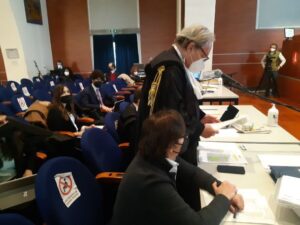
Che cosa si chiede di raccontare? Che cosa si intende rievocare? Che cosa si vuole farsi dire da vedove e vedovi, figli e fratelli sulle abitudini in vita di chi è morto d’amianto?

Il tenore delle domande e l’attesa di precise risposte hanno fatto intuire con chiarezza l’obbiettivo della difesa: instillare nei giudici dubbi sulle cause che hanno generato quei mesoteliomi, allontanando tempi e circostanze dalla responsabilità penale dell’imputato.
Diciamolo, domande e risposte sono state anche retoriche: quelle informazioni sono già contenute nel fascicolo processuale, nelle schede con il profilo completo di ognuna delle vittime, insieme ai relativi questionari redatti a suo tempo per il Registro Mesoteliomi (Renam); tuttavia, come è stato ribadito mercoledì dal presidente dell’Assise Gianfranco Pezone, a seguito di reclami da parte del pm Colace e dell’avvocato Esther Gatti di parte civile, la «prova si forma in aula». E, quindi, si proceda.
Partendo dall’assunto, ormai pacifico scientificamente, che la fibra di amianto provoca il mesotelioma, la questione su cui si sviluppa il contraddittorio tra accusa e parti civili da un lato e difesa dall’altro consiste nel decidere a chi vada attribuita la responsabilità dell’insorgere della malattia. Occorre cioè provare, per ognuno dei 392 casi, che il mesotelioma è riconducibile a fibre d’amianto diffuse criminosamente nel cosiddetto «periodo di garanzia» di Schmidheiny, in cui l’imprenditore svizzero era formalmente a capo di Eternit. Dal 1976 al 1986: è questo il decennio su cui ci si concentra. Il resto sta fuori dal processo.
Ecco, dunque, perché la difesa cerca di inoculare il dubbio (ruolo legittimo, e tuttavia difficile e doloroso per i famigliari delle vittime) che l’incriminata fibra mortale sia stata inalata prima del 1976: magari da un sottotetto in cui era stato steso uno strato coibentante di polverino, o dalla tettoia di un pollaio, oppure nel cortile, nel campo di bocce, nel campetto di calcio dell’oratorio in cui il polverino era stato posato per eliminare la fanghiglia, o dalla tuta impolverata dei genitori o dei nonni o degli zii che avevano lavorato all’Eternit. Attenzione, però: il polverino era uscito dalla fabbrica prima o dopo il 1976? E quei parenti avevano lavorato all’Eternit quando Schmidheiny non aveva ancora in mano le redini del comando? Se è così, l’imputato non può risponderne personalmente al processo. Altri imprenditori o dirigenti, ne sono stati, magari, responsabili? Forse sì, ma è passato tanto tempo, sono morti. Chiuso lì.
Alcune testimonianze, mercoledì, sono state utili a questa strategia difensiva; altre, al contrario, ne hanno disatteso gli auspici e hanno introdotto informazioni a supporto delle tesi dell’accusa.
Ecco, in ordine cronologico, la sintesi delle testimonianze che si sono susseguite.
Pier Luigi Olliaro, figlio di Luciano Olliaro.
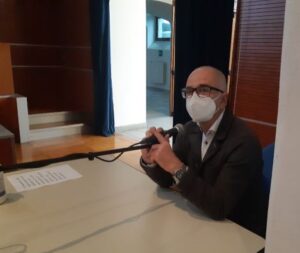
«Mio padre è vissuto, dal 1961, nella stessa casa in strada Pozzo San Evasio». Nel sottotetto c’era il poverino? «Sì. E, sì, aveva collaborato per fare quella coibentazione. E, ancora, sì, credo abbia contribuito alla sua rimozione nel 1990». E la zia Rosalia? «Mah, forse aveva lavorato all’Eternit, ma non ne sono certo, era emigrata in Argentina prima che io nascessi». E il padre Luigi? «Era mio nonno, sì era stato operario all’Eternit dal 1925 al 1950».
Corradino Orazio, figlio di Giuseppina Dattrino.

«Mia mamma aveva sposato mio padre, poliziotto. Dopo un periodo a Chiasso, fu trasferito ad Alessandria e poi a Casale: fino al 1963 hanno abitato in un alloggio sopra il commissariato, in piazza Statuto». C’era un campo di bocce livellato con il polverino? «Mah, mi pare di sì, vicino all’oratorio dell’Addolorata forse qualcosa c’era». Nel 1964 il trasferimento in via Montessori: il tetto del garage era di eternit? «Sì, e alcuni pezzi di onduline delimitavano l’orto, il giardino. Il vialetto di accesso era fatto di ghiaia mista a polverino. Tutto è stato bonificato oltre una decina di anni fa».
Patrizia Penati, vedova di Giovanni Bonelli.

«Mio marito, prima di trasferirci in Brianza nel 1987, ha sempre vissuto a Sala Monferrato». C’era un cascinotto per gli attrezzi coperto di lastre d’amianto? «Un casotto di campagna c’era, ma non so di che cosa fosse fatta la tettoia». Ha lavorato all’Eternit: «Fino al 1986, nel reparto lastre, poi la fabbrica è stata chiusa». Dopo, è stato operaio in una ditta di bancali e successivamente dipendente della società che gestisce l’acquedotto di Milano.
Piero e Rita Accatino, figli di Giuseppina Florian.

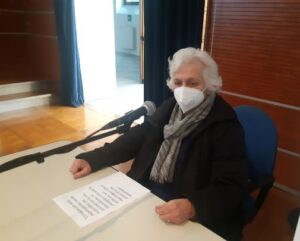
La madre ha abitato prima a Rolasco, frazione di Casale, e poi in via Mantova, sempre in città. Tetti d’amianto? «No, no». Ha lavorato all’Eternit, «una vita»: «Si è dimessa nel 1977 – spiega Rita -, quando io ho avuto mio figlio e lei ha fatto la nonna». Aveva l’asbestosi? «Non saprei. La causa della morte è stato il mesotelioma».
Maria Grazia e Giuseppe Arditi, figli di Rita Anselmo.
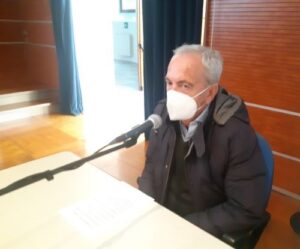
«Nostra madre era casalinga ed è sempre vissuta a Cellamonte, nella stessa casa. All’Eternit? Mai lavorato, no». Non è che frequentasse anche un’altra zona di campagna del paese? «In regione Castellaro, dice? Lì era mio papà che coltivava la terra. La mamma, forse, qualche volta ci è andata, di rado». E non c’era un ricovero per gli attrezzi? «Forse sì, mah. Era coperto di amianto? E’ stata rimossa quella tettoia? Non lo ricordiamo». E non fu scaricato del polverino nel cortile della casa di Cellamonte? I fratelli scuotono la testa, non ne hanno memoria. Invece ricordano «il polverino con cui era stato livellato il cortile della scuola materna ed elementare: i bambini lo raschiavano con le mani per fare le piste su cui giocare a biglie».
Ultimo Vetri, vedovo di Ombretta Bradiani.
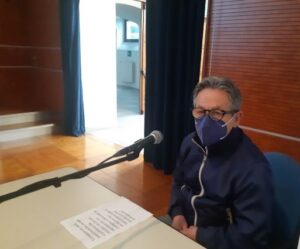
«Mia moglie è sempre vissuta a Casale Popolo, tranne un paio d’anni che ci eravamo trasferiti a Balzola». C’era in casa una lastra di amianto per limitare un passaggio? «Mah, io non ricordo». La signora, nella sua vita lavorativa. Impiegò strumenti che contenevano amianto, ad esempio ferri da stiro? «Mia moglie ha lavorato in una fabbrica tessile, sì, stirava». E la signora era fumatrice? «Ma no, fumatrice no, qualche sigaretta quando era molto giovane, poi aveva smesso». E suo suocero era operaio all’Eternit? «Si, per anni». E sua moglie lo incontrava? «Certo, era suo padre, stavamo a cinquanta metri». Il pm Colace interviene: fino a quando ha lavorato all’Eternit suo suocero? «Fino a quando lo stabilimento ha chiuso». Era il 1986.
Claudio Greppi, figlio di Giovanni Greppi.
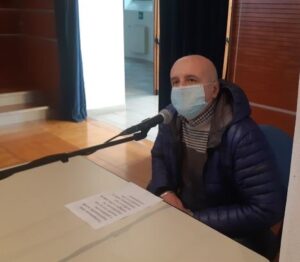
«Mio padre è sempre vissuto a Casale. Lavorava alla Smith Europea, prima come operaio, poi impiegato; facevano macchine per rilegare i libri». C’erano strumenti che contenevano amianto? «Che io sappia no». E nelle case in cui ha vissuto, c’era amianto? Aveva costruito lui un campo da bocce? «Mi sembra, ma non ricordo bene».
Simona Imarisio, figlia di Carla Minazzi.
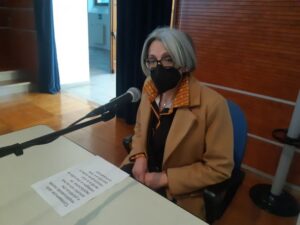
«Mia madre è vissuta a Casale, poi a Trino e poi di nuovo a Casale (al Ronzone, all’imbocco di salita Sant’Anna e a Oltreponte), fino a che è morta nel 1992. A Oltreponte sì, c’erano i garage coperti di eternit». E i genitori di sua madre che lavoro facevano? «La nonna raccontava che il nonno lavorava nelle miniere, poi forse all’Eternit. Ma più di tutto parlava delle miniere. Il fratello di mia madre, quello lo so per cento, ha lavorato all’Eternit, lui aveva l’asbestosi».
Marco Solerio, figlio di Angelo Solerio.
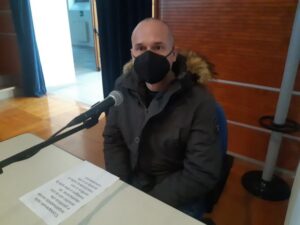
«Mio padre era disegnatore meccanico ed è sempre vissuto a Casale Popolo». Aveva hobby? «Sì, coltivava bonsai». E i suoi genitori? «I miei nonni sì, avevano lavorato all’Eternit».
Gabriella Bosco, figlia di Ferruccio Bosco.
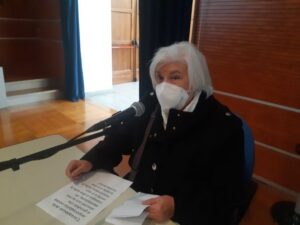
«Mio padre lavorava dentro lo stabilimento Eternit, nel senso che era dipendente di una ditta che svolgeva operazioni interne alla fabbrica. Nel dopoguerra, era poi stato assunto direttamente dall’Eternit e ne è stato dipendente fino a quando è andato in pensione, nel 1979». Fumava? «Come tanti, poi aveva smesso». Hobby? «Andava in baracca, in riva a Po: a giocare a carte, a bocce». Sul Po c’era una spiaggia…, si informa il pm Colace, riferendosi alla distesa che si era formata con gli scarichi di amianto nel fiume. «Sì, sì, ricordo la spiaggia sul Po, che per la gente di qui era come se fosse Rimini…».
Mario Bettonte, figlio di Italo Bettonte.
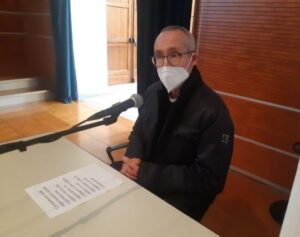
«Mio papà non avrebbe proprio voluto andare a lavorare all’Eternit, ma è stata una scelta obbligata, perché gli mancavano alcuni anni di contributi per andare in pensione. Prima aveva lavorato nella bottega di famiglia, un alimentari-latteria in via Sant’Evasio. E, insomma, per avere quei contributi ci è andato, dall’81 fino all’86, quando poi la fabbrica è stata chiusa. Era nel reparto tubi». I difensori rinunciano a fare altre domande, mentre il pm Colace è interessato ad approfondire. «Si era subito reso conto, mio papà, che le condizioni di lavoro non erano ottimali. In alcuni ambienti la situazione era invivibile». Le mascherine? «Mannò, non si sarebbe neppure riusciti a tenerle, c’era tanta polvere e si soffocava. Aveva una tuta blu, ma, quando arrivava a casa, il colore era sbiadito, era grigiobianca». E chi le lavava le tute? «Mia mamma». Dunque, lavorava nel reparto tubi. «E quando era di turno al sabato c’erano le pulizie… dei vetri, ad esempio, o delle vasche». Spieghi meglio. «Mio padre mi raccontava che, al sabato, sì mi pare proprio che si facesse di sabato, si usavano dei raschietti per grattare la crosta di polvere che si formava sulle vetrate, era così spessa che, quando veniva tirata via, tornava a entrare la luce nell’ambiente». E le vasche? «Erano quelle in cui i manufatti si facevano stagionare nell’acqua. Quando c’era l’acqua, di polvere ce n’era meno, ma poi veniva scaricata nel fiume e sul fondo restava del materiale di scarto, bisognava raschiarlo… l’ha fatto più di una volta». Indossava stivali, «sì, stivali, ne conservo un paio: rigidi come pezzi di legno». Siamo sempre tra il 1981 e il 1986, «sì certo. E si lamentava anche della polvere dove venivano frantumati i rottami di eternit a cielo aperto, che poi li si trasportava dentro la fabbrica e si mettevano nel mulino». E c’era tanta polvere… «eh, la facevano su con i badili».
Paola Budel, figlia di Dino Budel.
«Mio padre, da quando è arrivato dal Veneto che aveva 3 anni, è vissuto a Casale. Per 25 anni ha lavorato all’Eternit, fino a che lo stabilimento è stato chiuso». Nelle case in cui ha vissuto c’erano tettoie di amianto? «Ricordo il pollaio nella casa dei nonni». Fino al 1986 è stato operaio nella fabbrica del Ronzone. «Sì. Ed era molto preoccupato perché considerava la polvere come un pericolo». Anche in questo caso, il pm chiede approfondimenti. «Lui indossava la mascherina, la indossava sempre, per proteggersi, e alcuni colleghi lo prendevano un po’ in giro. Spalancavano pure le finestre, per non soffocare; anche d’inverno le spalancavano, e così, in più, si ammalavano pure per il freddo». Quando usciva, alla fine del turno, diceva “i prati intorno alla fabbrica brillano”: «Era questa l’impressione che aveva, un brillio, per via dei depositi di polvere sull’erba». E le tute chi le lavava? «Mia madre. Una parente la rimproverava, diceva che avrebbe dovuto portarle in lavanderia, perché era pericoloso lavarle a mano».
Elisabetta Costanzo, figlia di Antonietta Crevola.

«Mia mamma ha lavorato per 35 anni all’Eternit: ha smesso quando la fabbrica è stata chiusa. Nel 1986. Aveva 50 anni». Facevano controlli medici in fabbrica? «Mia mamma i controlli li faceva, perché diceva che le mancava il respiro». Controesame del pm Colace: che mansioni aveva sua mamma? «Tagliava le lastre e diceva che inalava tanta polvere. Di solito andava a lavorare in motorino, ma, quando finiva il turno di sera, andavamo in macchina, mio padre e io, a prenderla. E io la vedevo tanta polvere, tutto intorno».
Paola Demichelis, figlia di Franco Demichelis.

«Mio padre è vissuto prima nei dintorni di Casale e poi in città, fino alla morte. E’ stato un partigiano nella Brigata Garibaldi, mio papà…». Dopo la guerra fu assunto all’Eternit: «Ci è stato dal 1946 fino al 1983, quando andò in pensione». Aveva l’asbestosi? «Sì, tutto è cominciato così… io sono medico e ho seguito quel calvario, che ha causato tanta sofferenza nella nostra famiglia». Quindi aveva l’asbestosi, riconosciuta come malattia professionale. «Negli anni è peggiorato, con sempre maggiore difficoltà a respirare. E, dopo, è comparso il mesotelioma. Ha subito due interventi, è stato inutile… ma lo sai solo dopo. In seguito al secondo intervento, non si è più ripreso fino a che è morto, nel giorno di San Giuseppe, la festa del papà… fra tre giorni sono 28 anni…». Il pm fa domande sul tipo di mansioni che Franco Demichelis svolgeva: «Si occupava della manutenzione delle macchine, in vari reparti. E negli ultimi tempi, ha lavorato anche ai tubi di plastica. Lui lavorava sempre, quel che c’era da fare lo faceva». E lei ricorda quando tornava a casa, la tuta… «Ricordo quell’odore…». L’odore? «Sì, i suoi vestiti avevano un odore, li mettevamo fuori a prendere aria, ma non andava via… era l’odore dell’amianto». La voce si inceppa. «Un giorno – prosegue – dovevo fare una ricerca, ero alle elementari, e lui mi fornì della polvere d’amianto da portare a scuola, per farla vedere…».
Silvana Andreone, figlia di Evasio Andreone.

«Mio padre è sempre vissuto a Casale, a Oltreponte e per 35 anni ha lavorato all’Eternit, fino all’84/85: è andato in pensione quando la fabbrica stava per chiudere». Aveva l’asbestosi? «Sì. E poi il mesotelioma». Anche in questo caso, il pm chiede alla teste convocata dalla difesa di approfondire, pescando nei ricordi: che cosa le raccontava suo padre? «Era capoturno nel reparto tubi e si sentiva molto responsabile delle persone della sua squadra. Così, quando si intasava qualcosa che bloccava la catena di produzione… e capitava eh…, lui entrava dentro i tubi per sbloccare ciò che si era inceppato. Ecco, mi aveva colpito e mi è rimasta impressa la figura di mio padre dentro quei tubi». Ma usavano delle tute protettive, degli scafandri? «Non penso, lui non me l’ha mai detto». E le mascherine, le mettevano le mascherine? «Non penso mettessero le mascherine, avevano tutti il fiato corto per l’asbestosi».
Pierluigi Barbano, figlio di Remo Barbano.

«Mio padre ha lavorato all’Eternit, dal 1961 fino a che è andato in pensione». E prima, che altri mestieri ha fatto? «Il pescatore di professione». All’epoca c’era la Cooperativa di pescatori di Terranova. Hobby? «Andava a caccia».
Pierfranca Ferrarotti, vedova di Mario Portalupi.
«Mio marito ha sempre abitato a Casale». C’erano in giardino, sull’aia dei manufatti di amianto? «Forse qualcosa di vecchio c’era, ma non so se di eternit». All’Eternit ha lavorato: «Dal 1975 al 1983, era capoturno. Raccontava che non era un ambiente sano, specialmente quando dovevano fare le pulizie del reparto». E dopo l’83?, s’informa la difesa. «Ha fatto il rappresentante di olio industriale». E non ha avuto una ditta propria? «Sì, anche: vendeva cartongesso e tubi in pvc». Il pm Colace torna al periodo all’Eternit: com’erano le tute quando tornava a casa dalla fabbrica? «così impolverate che io non riuscivo a lavarle. Mio marito le infilava in una borsa e le portava a mia suocera, se ne occupava lei, erano troppo pesanti, io non ce la facevo».
Fabio Bozzetto, figlio di Salvatrice Ballarò, conosciuta come Salvina.

«Mia mamma è arrivata dalla Sicilia che era una ragazzina e, dall’età di 14 anni fino alla pensione, ha lavorato alla Linfleur, una fabbrica tessile». La domanda della difesa è immediata: usava strumenti, come ferri da stiro, che contenevano amianto? «No, la mamma cuciva». E abitava a Casale Popolo, non proprio a ridosso dello stabilimento Eternit… «Guardi che, in linea d’aria, è vicino: c’è solo il Po che divide Casale Popolo dall’Eternit!».
Oriana Zavattaro, figlia di Corinna Caloni.
«Mia madre è vissuta a Casale. Mio padre ha lavorato all’Eternit, fino all’84. E’ morto nell’89, anche lui mesotelioma». E chi lavava le tute? «Mia madre, sì, le sue tute le lavava mia madre».
Silvia Gario, figlia di Angela Luparia.

«Mia madre… mia madre era la mia mamma adottiva. La nostra storia comincia nel 1979: io l’ho conosciuta che avevo dodici anni». Ne ha un ricordo struggente, la voce si inceppa, fatica a ingoiare le lacrime. «Era caposala in Chirurgia, all’ospedale Santo Spirito di Casale». Nelle vicinanze di casa sua c’erano manufatti di amianto: «In salita Sant’Anna, un tetto di eternit che è stato rimosso nell’85. Invece, in strada San Martino, i vicini avevano il polverino nel cortile. E lei, quando era già malata, era molto preoccupata e mi diceva “Guarda che di là – e indicava la casa dei vicini – c’è l’amianto”. Io ero sprovveduta, quando si parlava di amianto pensavo ai tetti. Stava già per morire ed era preoccupata che io mi ammalassi». Spieghi bene: «Erano le sue ultime settimane di vita, la mamma era molto provata e mi disse di questo polverino che era stato portato nel cortile vicino. Io replicai che era roba vecchia, ma lei insisteva, “l’hanno messo nel 1979, quando ci siamo conosciute…”, il suo ultimo pensiero era per me… la sua paura che io mi ammalassi d’amianto… anzi, mi ha chiesto persino scusa per avermi fatto vivere lì».
Alla prossima udienza, lunedì 21 marzo, saranno ascoltati altri famigliari delle vittime.
Translation by Vicky Franzinetti
Eternit Hearing March the 16th, 2022/Udienza Eternit 16 marzo 2022
By Silvana MOSSANO
33 Fact witnesses summoned, 22 heard
Defense lawyers Astolfo Di Amato and Guido Carlo Alleva had announced their intention to hear some ninety family members of the victims whose names appear PPs Drs Gianfranco Colace and Mariagiovanna Compare’s list at the Eternit Bis, being heard in the Court of Assizes in Novara. They are the defense lawyers for Stephan Schmidheiny, accused of the willful murder of 392 people from Casale who died due to asbestos.
The c. 90 family members, will be heard in three hearings. On Wednesday, March the 16th , a little more than twenty were heard. Some had sent the medical certificates to account for their absence and the defense (lawyers Guido Carlo Alleva, Maria Cristina Amoruso and Alessio Di Amato) agreed to exclude the other witnesses that had also been called.
My question is what were they going to say? What do you ask widows and widowers, children and sibling on the habits of the lives of those who died in grief?
The questions and the expectation of precise answers made the defense’s strategy clear: to instill doubts in the judges on the causes of those mesotheliomas, shifting the time frame times and circumstances thus releasing the defendant from the criminal liability.
Questions and answers were also rhetorical devices: the information is already in the trial file, in the files with the complete profile of each of the victims, together with the relative questionnaires drawn up at the time by the Mesothelioma Registry (Renam) for the Region. However, as it was repeated Wednesday by Gianfranco Pezone, the president of the Court of Assizes, following objections from the PP Colace and plaintiff lawyer Esther Gatti, the “evidence is gathered in the courtroom”. And, therefore, overruled.
Starting from the scientifically undisputed assumption, that asbestos fibers causes mesothelioma, the issue on which the court case impinges on consists in deciding who is responsible and therefore for the onset of the disease. In other words, for each of the 392 cases it is necessary to prove, that the mesothelioma can be traced back to the asbestos fibers criminally spread during the so-called so-called “periodo di garanzia“(the time for which SS is held responsible and is liable) of Schmidheiny, in which the Swiss entrepreneur was the CEO (as well as owner) of Eternit. From 1976 to 1986: this is the decade we are focusing on. The rest is outside the remit of the trial. This is why the defense is trying to sow the seed of doubt (a legitimate role, and yet difficult and painful for the families of the victims), suggesting that the deadly fiber was inhaled before 1976: perhaps from an attic in which it had been laid, , or from the roof of a chicken coop, or in the courtyard, on the bocce run, in the parish soccer field where the dust had been laid to cover the mud and sludge, or from the dusty overalls of parents or grandparents or uncles who had worked at Eternit. Beware, however: can we date the dust before or after 1976? And had those relatives worked at Eternit when Schmidheiny was not yet in charge? If so, the defendant cannot answer at the trial. Were other entrepreneurs or executives, have been, perhaps, responsible? Possibly so yes, but so much time has passed, they are dead. Matter closed.
Some of the witnesses on Wednesday bolstered this defensive strategy; others, on the contrary, helped the plaintiffs’ strategy and introduced information to support the PP ‘s accusations.
The summary of the witnesses follows in chronological order:
Piero Luigi Ogliaro, son of Luciano Ogliaro.
“My father lived, since 1961, in the same house in the street Pozzo San Evasio”. Was there polverino[1] In the attic there? “Yes. And, yes, he helped with the insulation. And, again, yes, I believe he helped with the removal in 1990.” What about Aunt Rosalia? “Well, maybe she had worked at the Eternit plant, but I’m not sure, she had emigrated to Argentina before I was born”. And Luigi? “He was my grandfather, yes he had been a worker at Eternit’s from 1925 to 1950”.
Corradino Orazio, son of Giuseppina Dattrino.
“My mother had married my father, a policeman. After a period in Chiasso, he was transferred to Alessandria and then to Casale: until 1963 they lived in lodgings above the police station, in piazza Statuto”. Was there a there a bocce fields leveled with polverino? “Well, I think so, maybe there was something near the parish of Maria Addolorata. Perhaps there was something there. In 1964, they moved to Via Montessori. Was the garage roof made of Eternit? Yes, and some pieces of corrugated AC sheets bordered the backyard. The driveway was made of gravel mixed with asbestos dust. Everything was cleaned up over a decade ago.
Patrizia Penati, widow of Giovanni Bonelli.
My husband had always lived in Sala Monferrato before we moved to Brianza in 1987.” Was there a tool shed covered with asbestos slabs? “There was a tool shed, but I don’t know what the roof was made of. Did you work at Eternit? Until 1986, in the workshop that made slabs, then the factory closed.
Then the factory was closed. After that, he was a worker in a pallet company and then an employee of the company that manages the Milanese Waterworks.
Piero and Rita Accatino, Giuseppina Florian’s children.
Their mother lived first in Rolasco, a hamlet of Casale’s, and then in via Mantova, also in the town. Were there asbestos roofs? “No, no.” She worked at Eternit, “for a lifetime”: She resigned in 1977 and her daughter Rita explains she had a son so Giuseppina became a full time grandmother”. Did she have asbestosis? I don’t know. The cause of death was mesothelioma.”
Maria Grazia and Giuseppe Arditi, Rita Anselmo’s children.
“Our mother was a homemaker and always lived in Cellamonte, in the same house. Did she ever work at Eternit? No she never worked, no.” did she spend time in other areas in the countryside? “In the Castellaro region, you say? My father worked the land there. My mother, perhaps, sometimes went there, rarely”. And wasn’t there a tool shed? “Maybe there was’ Was it covered with asbestos? Was that shed removed? We are sorry but we can’t remember.” And wasn’t there polverino dumped in the backyard of the Cellamonte house? The brother and sister shake their heads, they have no memory of it. Instead, they remember “the polverino with which the courtyard of the nursery and elementary school had been leveled: the children scraped it with their hands to make tracks to play marbles on it.
Ultimo Vetri, widower of Ombretta Bradiani.
“My wife has always lived in Casale Popolo, except for a couple of years we spent in Balzola.” Was there a slab of asbestos in the house to limit a passageway? “Sorry, I don’t remember.” Did your wife work? Did she employ tools that contained asbestos, for example irons? “My wife worked in a textile factory, yes, she ironed” And was she was a smoker? “But no, not a smoker, a few cigarettes when she was very young, then she stopped”. And was your father-in-law a worker at the Eternit? “Yes, for years.” And did your wife meet him? “Of course, he was her father, we were lived fifty meters apart”. PP Dr Colace intervenes: how long did your father-in-law work at Eternit for? “Until the plant closed”. That was 1986.
Claudio Greppi, son of Giovanni Greppi.
“My father lived in Casale his whole life. He worked at Smith Europea, first as a worker, then as an office worker; they made book binding machines.” Were there any tools that contained asbestos? “Not to my knowledge.” And was there asbestos in the houses where he lived? Had he built a bocce field? “I I think so, but I really don’t remember.”
Simona Imarisio, daughter of Carla Minazzi.
“My mother lived in Casale, then Trino and then back to Casale at Ronzone, where the SantAnna hill starts and in then in Oltreponte, where she was until she passed away in 1992. In Oltreponte there were garages with asbestos roofs. And what did your mother’s parents do for a living? “My grandmother used to say that my grandfather worked in the mines, and then maybe at Eternit. But most of all she talked about the mines. My mother’s brother, I am sure, he worked at the Eternit plant, he died of asbestosis”.
Marco Solerio, son of Angelo Solerio.
“My father was a draftsman and lived all his life in Casale Popolo.” Did he have hobbies? “Yes, he grew bonsai trees.” What about his parents? “My grandparents had worked at Eternit”.
Gabriella Bosco, daughter of Ferruccio Bosco.
“My father worked at the Eternit plant, in the sense that he was an employee of a company that carried out work at the plant. He was an employee of a company that carried out work inside the factory. After the war, he was then hired directly by Eternit and was an employee until he retired in 1979”. Did he smoke? “Like many, then he had stopped.” Hobbies? “He used to go to the shed on the banks of the Po: to play playing cards, bocce. “Was the a beach along the River Po, asked PP Dr Colace,referring to the expanse that had formed with the dumping of asbestos in the river. “Yes, yes, I remember the beach on the Po, which for the people here was like if it was Rimini[2].”
Mario Bettonte, son of Italo Bettonte.
“My dad really didn’t want to go to work at Eternit, but it was choice, because he was missing a few years of contributions to retire. He had previously worked in the family store, a grocery and dairy shop store in Via Sant’Evasio. And, in short, to get the pension benefits he lacked he went there from 1981 to 1986. That ended when the factory was closed. He was in the pipe manufacturing department”. The defense did not ask any further questions, while the prosecutor, Dr . Colace, was interested in learning more. “My father had immediately realized, he had my dad, that the working conditions were not optimal. In some workshops was unbearable. Masks? “Hell, you couldn’t even wear them there was so much dust you would suffocate”. He had a blue overalls, but when he got home, you couldn’t see the color, it was grayish white. And who washed her overalls? “My mother did.” So, she worked in the pipe manufacturing. When she was at work on Saturdays, she cleaned the windows, for example, glass, for example, or the tubs. My father used to tell me that on Saturdays, yes I believe it was done on Saturdays, they would use some scrapers to scrape off the crust of dust that formed on the panes, which was so thick that, when it was pulled off, the light came back into the room. And the tanks? “They were the ones in which the artifacts were left in the water. When there was water, there was less black powder. The water it was but then it was discharged into the river and waste material remained on the bottom of the tub. You had to scrape it off, he did it more than once” “Did he wear boots?”: “Yes, boots, I have a pair: stiff as pieces of wood”. We are still between 1981 and 1986, “Yes of course. And he also complained about the dust where and he also complained about the dust where the asbestos waste was crushed under the open sky, which was then and there was a lot of dust. And there was so much dust, “eh, they shoveled it “.
Paola Budel, daughter of Dino Budel.
” Ever since he had emigrated from Veneto when he was 3 years old, my father lived in Casale. For 25 years he worked at Eternit, until the plant was closed.” Were there asbestos roofs in the houses you lived in?””I remember the chicken coop in my grandparents’ house.” Until 1986 was he a worker in the Ronzone factory. “Yes. And he was very concerned because he considered the dust as a danger.” The Prosecution asked on cross. “He wore the mask, he always wore it, to protect himself, and some of his colleagues used to tease him a little bit. They opened the window wide, so as not to suffocate, even in winter they opened them wide, and, and they would also get sick from the cold. When he came out at the end of his, he would say the meadows around the factory were twinkling. That was the impression he had, a glow, because of the dust deposits on the grass. “And who washed the overalls? “My mother. One relative told her off her, saying she should have taken them to the laundry because it was because it was dangerous to wash them by hand”.
Elisabetta Costanzo, daughter of Antonietta Crevola.
“My mom worked at Eternit for 35 years: she quit when the factory closed in 1986. She was 50 years old.” Did they do medical checks in the factory? “My mom went for checkups because she said she was short of breath. PP Dr Colace’s asked in cross: what tasks did your mom have? “She cut the slabs and said she inhaled a lot of dust. She usually went to work on her scooter, but when the evening shift ended, my father and I, went to pick her up. And I would see so much dust, all around her.”
Paola Demichelis, daughter of Franco Demichelis.
“My father lived first around Casale and then in the town, until his death. [during the war] He had been a partisan [fighting the Fascists and Germans] in the Garibaldi Brigade, my dad “. After the war, he was hired at Eternit: “He was there from 1946 until 1983, when he retired”. Did he have asbestosis? “Yes, it all started: I am doctor and I followed that ordeal, which caused so much suffering in our family. He suffered from asbestosis which was recognized as an occupational disease. “Over the years it got worse, with increasing difficulty in breathing. And, later, mesothelioma developed. He had surgery twice, it was unnecessary but you only know that afterwards. Following the second surgery, he never recovered until he died on St. Joseph’s Day, Father’s Day. Father’s Day in three days it will be 28 years “. The PP asked asks about the type of tasks that Franco Demichelis carried out: “He was responsible for the maintenance of the workshops. And in recent times, he also worked on the pipes of plastic. He always worked, he did whatever was needed.” And she remembered when she came home, the overalls “I remember that smell.” The smell? “Yes, his clothes had a smell, we would put them outside to air, but it wouldn’t go away, it was the smell of asbestos”. The voice chokes. “One day I was in primary school, and he provided me with some asbestos dust to take to school and show.
Silvana Andreone, daughter of Evasio Andreone.
“My father lived in Casale, in Oltreponte all his life and for 35 years he worked until 1984/85: he retired when the factory was about to close”.. Did he suffer from asbestosis? “Yes. And then mesothelioma.” Again the PP asked the defense witness to detail her answer delving in her memories: what did her father tell her? “He was a shift foreman in the workshop and he felt very responsible for the people in his team so, when something clogged up and blocked the production chain production line and it happened, he would get inside the pipes to unblock what had jammed it. There, I was struck and I was impressed by my father inside those pipes”. Did they use protective suits, diving suits? suits? “I don’t think so, he never told me.” And the masks, did they did they wear masks? “I don’t think they were wearing masks, they were all short of breath because of asbestosis.”
Pierluigi Barbano, son of Remo Barbano.
“My father worked at Eternit, from 1961 until he retired.” And before that, what other jobs did he do? “he was fisherman by profession.” At the time there was the Terranova Fishermen’s Cooperative. Hobbies? “He went hunting.”
Pierfranca Ferrarotti, widow of Mario Portalupi.
“My husband lived in Casale all his life.” In the garden, were there any asbestos artifacts? “Maybe something old was there, but I don’t know if it was made of Eternit.” He worked at Eternit from 1975 to 1983, he was a shift foreman. He said that it was not a healthy environment, especially when they had to cleaning of shop floor .” And after 1983?, the defense asks . “He was a an industrial oil salesman.” And wasn’t he self employed? “Yes,: he sold plasterboard and pvc pipes.” PP Dr Colace asked about the time at Eternit: what state were hi overalls when he came home from the factory? “So dusty that I couldn’t wash them. My husband used to put them in a My husband used to put them in a bag and bring them to my mother-in-law, she took care of them, they were too heavy, I couldn’t do it”.
Fabio Bozzetto, son of Salvatrice Ballarò, known as Salvina.
“My mother emigrated from Sicily when she was a little girl and, from the age of 14 until she retired, she worked at Linfleur, a textile factory.” The defense’s question follows: did she use tools, such as irons that contained asbestos? “No, mom sewed.” And she lived in Casale Popolo, not exactly close to the Eternit plant “Look, as the crow flies, it’s close by: there is only the Po River that divides Casale Popolo from Eternit!
Oriana Zavattaro, daughter of Corinna Caloni.
“My mother lived in Casale. My father worked at Eternit until 1984. He died in 1989, also of mesothelioma.” And who washed the suits? “My mother, yes, my mother washed his overalls”.
Silvia Gario, daughter of Angela Luparia.
“My mother was really my adoptive mom. Our story begins in 1979: I met her when I was twelve years old”. Silvia chokes, she struggles to swallow her tears. “She was a matron in Surgery, at the Santo Spirito Hospital in Casale”. Near her house, there were asbestos artifacts: “In the Sant’ Anna slope, there was an asbestos roof which was removed in 1985. Instead, in San Martino street, the neighbors had dust in the courtyard. And when she was already ill, she was very worried and she would tell me that there was asbestos in the neighbor’s house. I was clueless; when people talked about asbestos, I thought of roofs. She was already dying and she was worried that I would get sick”. Explain well: “It was the last weeks of her life, mom was very tired and told me about this dust that had been brought into the neighboring yard. I I replied that it was old stuff, but she insisted, they put it there in 1979, when we first met, her last thought was for me was her fear that I would fall ill, in fact, she even apologized to me for making me live there”.
At the next hearing, Monday, March 21, other family members of the victims will be heard.
[1] crushed broken asbestos cement sheets and pipes. Besides the emission from the plant, a relevant source
of exposure in the city was the dispersion of production tailings, in particular from lathing of pressure pipes (so
called polverino– “fine dust”). The material was given freely to whom was interested and was used mostly for
thermal insulation in buildings and hardening of footpaths and courtyards
[2] A well known beach resort in Italy on the Adriatic Sea
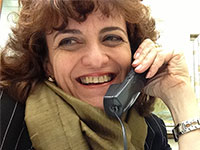
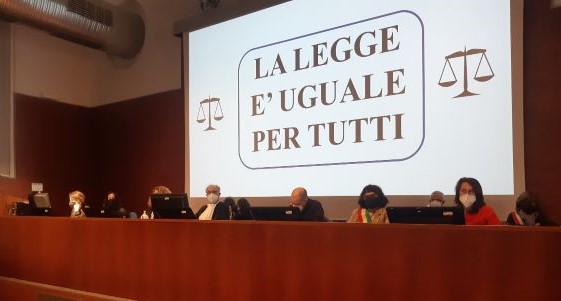

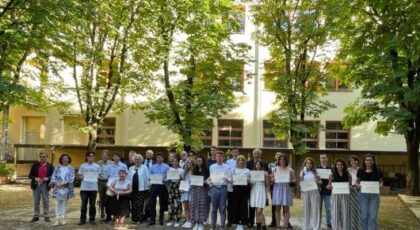


Sempre più “ingarbugliato “ questo processo soprattutto per abilità degli avvocati che fanno il loro mestiere. Ma la verità è una sola che i nostri cari non ci sono più a causa del mesotelioma! Unica verità a mio modesto avviso.
Ottime ed utili sintesi Silvana!
Grazie per questo tuo costante lavoro, più che prezioso per il presente e per il futuro..
Questa volta per la difesa la chiamata,piuttosto cinica, dei famigliari si è trasformata in autogol: le testimonianze che ricordavano il lavoro straordinario di alcuni ex lavoratori per operazioni di pulizia svolte manualmente e senza alcuna misura di sicurezza, nel pieno “periodo svizzero”,hanno ribaltato l’intenzione di scaricare le responsabilità nel precedente “periodo belga”.
Davvero molto significativa la testimonianza sulla presenza del polverino, impiegato in un cortile vicino all’abitazione della vittima e famiglia, nel 1979, in pieno periodo svizzero!…..
Grazie Silvana per le dettagliate informazioni. Mi sorge una domanda, come è possibile che non sia ancora stato condannato.
Buongiorno Silvana,
Sono Silvia la figlia di Angela Luparia, la ringrazio per aver compreso il forte legame che avevo che ho tutt’ora con mia madre.